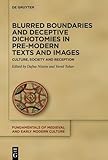Blurred Boundaries and Deceptive Dichotomies in Pre-Modern Texts and Images : Culture, Society and Reception / ed. by Dafna Nissim, Vered Tohar.
Material type: TextSeries: Fundamentals of Medieval and Early Modern Culture ; 28Publisher: Berlin ; Boston : De Gruyter, [2023]Copyright date: ©2024Description: 1 online resource (VII, 258 p.)Content type:
TextSeries: Fundamentals of Medieval and Early Modern Culture ; 28Publisher: Berlin ; Boston : De Gruyter, [2023]Copyright date: ©2024Description: 1 online resource (VII, 258 p.)Content type: - 9783111243566
- 9783111244105
- 9783111243894
- 940.1 23/eng/20240229
- D117 .B57 2024
- D117 .B58 2024
- online - DeGruyter
- Issued also in print.
| Item type | Current library | Call number | URL | Status | Notes | Barcode | |
|---|---|---|---|---|---|---|---|
 eBook
eBook
|
Biblioteca "Angelicum" Pont. Univ. S.Tommaso d'Aquino Nuvola online | online - DeGruyter (Browse shelf(Opens below)) | Online access | Not for loan (Accesso limitato) | Accesso per gli utenti autorizzati / Access for authorized users | (dgr)9783111243894 |
Frontmatter -- Acknowledgements -- Table of Contents -- Blurred Boundaries in Pre-Modern Texts and Images: Aspects of Audiences and Readers-Viewers Responses -- The Sacred and the Profane in German Courtly Romances and Late Medieval Verse Narratives: With an Emphasis on Ulrich Bonerius and Heinrich Kaufringer -- The Poetic and Ideological Blurring of Boundaries in the Jewish Book of Ethics Orḥot Ṣaddiqim -- Laughing at Death: Blurred Boundaries in Giotto’s Last Judgment -- The Popular in Service of the Sacred: The Sculpted Musicians of Santiago de Compostela -- Image and Legend of Saint Margaret as an Aid in Childbirth Rituals -- Violent Women and the Blurring of Gender in some Medieval Narratives -- On the Heavenly and the Earthly, the Secular as Sacred – A New Reading of Medieval Hebrew Fables -- The Secular and the Sacred in a Bifolio from Louis of Laval’s Book of Hours and Its Spiritual Use -- Between Psalter and “Mirrors for Princes”: On the Moral and Didactic Messages in BL Cotton MS Domitian A XVII -- Visual and Textual Authority: Reading Chevalier in Manuscripts of La Vie des pères -- Aspects of Italian and Flemish Identity in Relation to Book Illumination: Reception of Devotional and Antiquarian Ideas through Depictions of Jewelry -- List of Illustrations -- Notes on Contributors -- Index
restricted access online access with authorization star
http://purl.org/coar/access_right/c_16ec
This collection of essays focuses on the way blurred boundaries are represented in pre-modern texts and visual art and how they were received and perceived by their audiences: readers, listeners, and viewers. According to the current understanding that opposing cognitive categories that are so common in modern thinking do not apply to pre-modern mentalities, we argue that individuals in medieval and pre-modern societies did not necessarily consider sacred and secular, male and female, real and fictional, and opposing emotions as absolute dichotomies.The contributors to the present collection examine a wide range of cultural artifacts – literary texts, wall paintings, sculptures, jewelry, manuscript illustrations, and various objects as to what they reflect regarding the dominant perceptual system – the network of beliefs, worldviews, presumptions, values, and norms of viewing/reading/hearing different from modern epistemology strongly predicated on the binary nature of things and people. The essays suggest that analyzing pre-modern cultural works of art or literature in light of reception theory can lead to a better understanding of how those cultural products influenced individuals and impacted their thoughts and actions.
Issued also in print.
Mode of access: Internet via World Wide Web.
In English.
Description based on online resource; title from PDF title page (publisher's Web site, viewed 02. Jun 2024)


